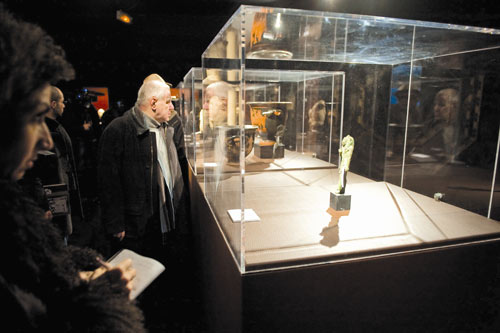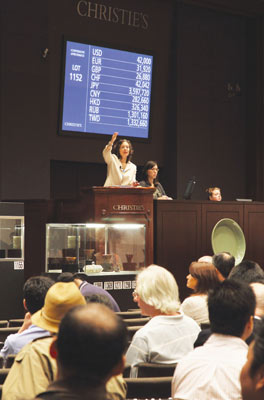Prime
Asian art market sizzles
Updated: 2011-04-01 11:27
By Kelly Chung Dawson (China Daily)
|
|
|
|
Record purchases by Chinese collectors keep market humming with activity and cash registers ringing. Kelly Chung Dawson reports from New York.
Prestigious auction houses Sotheby's and Christie's both recently released 2010 results, revealing blockbuster numbers despite a worldwide recession. In fact, Christie's numbers broke records for the 245-year-old company - and both auction houses reported huge gains in the Asian market.
According to Kevin Ching, chief executive officer of Sotheby's Asia, the contribution of Asia sales to Sotheby's worldwide sales grew to 16 percent in 2010, from 5 percent in 2004. Christie's annual report, released in late January, indicated sales of $5 billion worldwide, an increase of 53 percent from 2009. Christie's autumn 2010 sale alone reached $414 million, a 95 percent increase from the year before and a record sale for any international auction house in Asia, says Jonathan Stone, managing director of Christie's Asia division, in an interview with China Daily.
"The Chinese art market is probably growing faster than any other country's art market," Stone says. Asian buyers also spent more in the Western market, he says. Spending by collectors from the Chinese mainland grew by 116 percent worldwide between 2008 and 2009, and even more between 2009 and 2010, he says.
Ching reports similar gains for Sotheby's. The number of buyers from China who purchased objects worth $500,000 or above from Sotheby's increased by almost 400 percent between 2004 and 2009, Ching says.
"Part of the reason is that art, jewelry, watches and wine are increasingly seen as a viable investment, and compared to other asset classes, are seen as more tangible and a stable store of value," Stone says.
"Inflation and the political instability around the globe have caused the Asian collectors to look more closely at art as an alternative investment," Ching says. "The relatively unaffected Asian economy outside Japan, coupled with Chinese buyers' wealth, contributes to the persistent, strong art market."
Morgan Long, head of art investments for the Fine Art Fund, an international investment group, reports that the largest boom has been in Chinese antiquities.
"There's been a massive jump in the number of people (in China) putting their money into art," she tells China Daily. "There's been a lot of interest in bringing Chinese pieces back to China, in bringing heritage home. People are interested in pieces that have been scattered around the globe over the last hundreds of years, and new millionaires and billionaires want to put their money into something that's viewed as historically important."
She estimates that 90 percent of buyers in the Chinese market are of Chinese descent, with Chinese buyers worldwide numbering somewhere between 5 percent and 15 percent. "That's growing fast though," she says. "There's been a huge increase in the last two years."
Buying publicly at auctions seems to appeal to Chinese and Russian buyers, she says, who are often buying with new money they are eager to flaunt.
"Russian buyers like being seen spending money," she says. "The mentality is that it's a competition, and a lot of people see Chinese buyers as having the same mentality, with the long tradition of gambling in China. There's prestige in being seen spending a lot of money in public."
In some cases, this has led to some buyers disappearing after buying at auctions, Long says. She points to the example of "the $70 million vase", a Chinese vase made in the Qianlong period (1711-1799) that was sold for the extraordinary sum at a London auction in 2010 but never actually purchased.
I.M. Chait, owner and founder of Chait Gallery/Auctioneers, a California-based auction house that has been in the business of trading Chinese art for more than 40 years, says that there were rumors that the vase's sale price had been pushed artificially by various auction houses to set a high precedent that didn't reflect the vase's actual market value. This is a common practice, he says.
However, prices of Chinese art pieces have undeniably jumped, he says.
"There is no ceiling of where these things can go in terms of price," Chait says. "There is no global recession in China. Its economy is growing leaps and bounds and will continue to do so, I believe."
The global art market has also been influenced considerably by the Internet, he says.
"There are no longer any hidden treasures to be found in auctions as everyone uses the Internet," he says. "The big caveat is that because prices have skyrocketed, there are a great number of copies on the market."
Chait makes it a point to visit China several times a year specifically to inspect copies, he says.
Auction houses expect Chinese buyers to expand out of the Chinese market. "As the purchasing power of collectors grow, they have become more sophisticated, discerning and 'hungry', especially at the top end, resulting in the buoyancy and confidence in this market," Ching says. "We've seen an expansion of collecting taste in Chinese buyers."
Stone also said that Chinese buyers are branching out into Western and contemporary art.
"Although many Chinese buyers begin with Chinese art because they are familiar with the subject matter and the background and they wish to own rare and exquisite art from their own culture, they have been increasingly active in other collecting categories as their familiarity with other cultures increases," he says.
For example, in Christy's New York sales, the company has seen an increase in Chinese purchasing in categories including Impressionist & Modern Art, Post-War, European decorative arts, and interiors. London and Paris sales have seen the same trend, he says.
"I think we're going to see new records set," Long says of a just-announced upcoming Sotheby's sale in Hong Kong in April of contemporary pieces from The Ullens Collection, and additional pieces of Imperial Porcelain from the Meiyintang Collection. The company estimates to bring in more than $300 million in a sale "of historic importance", according to Sotheby's annual report.
"The Chinese market is growing at an amazing rate, and we expect the influence of the Chinese market to continue to rise in the coming years," Ching says.
Stone agrees. "If the world economy continues to recover, I believe the art market will continue to expand and enjoy an organic growth."

Specials

My China story
Foreign readers are invited to share your China stories.

Economy slows down
A 9.5 percent growth in the second quarter eased concerns over a hard landing.

Mullen visits military bases
Top US military officer praised the transparency of the Chinese military.

